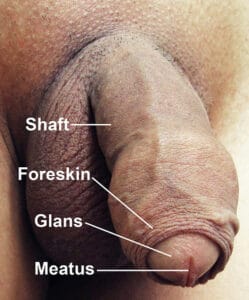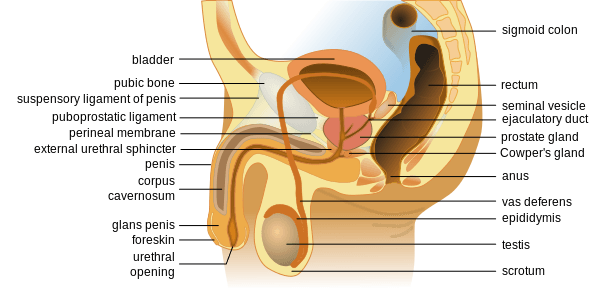Getting to Know Your Tackle
This month we discuss the male sexual anatomy. As it is more than just the penis and testicles, we will take a tour of men’s anatomy and discover some new knowledge. I am surprised how many people I work with in therapy do not know the sexual anatomy of men; including men themselves. The extent of many people’s knowledge is the penis shaft and the testicles in the scrotum. There is so much more.
External Anatomy
The external anatomy includes the penis, the scrotum and the testicles. This is all most people think about, yet a man’s sexual anatomy is more complex and interesting than just these. Knowing more about male sexual anatomy can help with giving and receiving sexual pleasure, and promote understanding about what is normal.
Penis
The penis is the largest part of the male sexual anatomy. The penis is made up of three regions: the root, the penis shaft (body), and the glans. The penis varies in size and shape between men – all penises are normal. Most men have an average erect size penis between 13.9 cm to 17.75cm (5.5” to 7”).
Penis Root
The root, or radix, of the penis consists of the bulb of the penis in the middle of legs, or crus of the penis. The radix can be felt in the perineum area of the body when a man has an erection. It is the radix which attaches the penis to the rest of the body.
Penis Shaft
The body or shaft of the penis, also known as the corpus. The body of the penis is cylindrical and contains three chambers of erectile sponge-like tissue which become engorged with blood during erections. The two chambers on the top side of the penis are called the corpora cavernosa. The third chamber on the underside of the penis is called corpus spongiosum. The skin of the penis is elastic allowing it stretch during an erection. The urethra (tube for carrying urine and semen) is contained in the shaft.
Glans
The glans of the penis is the head or “knob” of the penis. The glans is covered by a foreskin in uncircumcised men. It contains the meatus, or place where the urethra exits the body. The edge of the glans is called the corona, or coronal ridge. The frenulum is the thin piece of flesh on the underside of the glans which connects the shaft and glans, and connects the foreskin in uncircumcised men. Circumcised men still have a frenulum – it is often a skin tag on the underside of the glans. The glans contains many nerve endings.
The Scrotum and Testes
The scrotum, or sac, is the bag-like pouch which holds the testes. The scrotum sits behind and below the penis, and contains many nerves and blood vessels. The scrotum has a climate control function and a protection function for the testes. When a man gets a fright the Cremaster muscle (in the wall of the scrotum) pulls the testes closer to the body. This also happens during cooler temperatures. For healthy sperm production the testes require a slightly cooler temperature than the body. The wrinkled appearance of the scrotum is controlled by the Dartos muscle. When the temperature is hot, like on a warm day or during a warm shower, the scrotum relaxes away from the body – this is the result of the Cremaster and Dartos muscles.
The testes, or testicles (or balls) are oval shaped and vary in size between men. The testes are found in the scrotum and are secured at either end by the spermatic cord. The testes are responsible for the generation of sperm, as well as testosterone, which is the primary male sex hormone. The testes consist of coiled tubes known as seminiferous tubules. It is in these coiled tubes sperm are made.
The Epididymis is the long coiled tube found on the backside of each teste. The epididymis acts as an incubator, maturing the sperm, as well as being responsible for the storage and transport of sperm. Sperm takes approximately 10 to 14 days to mature. Faulty and old sperm are reabsorbed. The sperm is transported to the vas deferens during arousal via muscular contractions.
Internal Sexual Anatomy
There is more to the male sexual anatomy inside the body. These include: the tubes which carry the sperm (vas deferens); the glands responsible for adding fluid to the sperm to create semen or ejaculatory fluid; and the prostate gland.
Vas Deferns
The vas deferens, or seminal duct, carries mature sperm from the epididymis into the pelvic cavity. The vas deferens is approximately 30cm long. When a man has a vasectomy (usually for contraceptive purposes) a small piece is cut out of the vas deferens so the sperm cannot get through, and they are reabsorbed instead.
There are three glands called the accessory glands. These glands function to lubricate the pathway for sperm and also nourish sperm on their journey from the epididymis to the glans during ejaculation.
Seminal Vesicles
The seminal vesicles are sac-like and attached to the vas deferens to one side of the bladder. The seminal vesicles produce a yellowish sticky fructose (sweet) fluid which provides sperm with fuel (energy) and aids in their motility, or movement, once ejaculated. Seventy per cent of semen is made up of fluid from the seminal vesicles.
Prostate Gland
The prostate gland is located below the bladder and between the bladder and rectum. The prostate gland adds a calcium-based fluid to the sperm in the production of semen. It is this prostatic fluid which makes semen white-ish in colour and clumpy or sticky. The prostate gland can be felt through the rectum and also contains many nerve endings. For many men, stimulation of the prostate gland leads to orgasm and ejaculation.
Bulbourethral Glands
These pea-like glands, also known as Cowper’s glands, are found on either side of the urethra just below the prostate gland. The Cowper’s glands produce a clear like substance which empties directly into the urethra. This fluid is also known as pre-ejaculatory fluid, or pre-cum, and acts to lubricate the urethra and also neutralise any residual urine in the urethra.
Perineum
The perineum, also known as the guiche, gooch, notcha (notcha balls and notcha arse), is the area of skin between the scrotum and the anus. The radix of the penis can be felt in the perineum, especially when a man is erect. The perineum contains nerve endings and can be very sensitive for some men, so playing with the perineum can be sexually stimulating. Pressure on the perineum also puts pressure on the prostate gland.
The Anus
The anus is the opening of the rectum (see the earlier columns on anal play). The anus consists of the internal and external sphincter muscles. The anus has nerve endings and is sensitive to touch. Lightly touching, or putting mild pressure on the anus can be sexually stimulating. When playing with the anus ensure you do not transfer bacteria from the anal area to the vulva or mouth – wash your hands or use a form of barrier protection like latex gloves on hands, dams or condoms.
The Skin
Do not forget the skin; it is our largest organ and contains millions of nerve endings. When we consider our sexual anatomy, remember to include the skin. It is a vital part of everybody’s sexual anatomy and adds to the pleasure of stimulation. Don’t just focus on the reproductive organs – focus on the whole body and the person.
When next playing by yourself, or with a partner, why not explore yourself a little more? There is more to a man’s sexual function than just an erection – and more to his anatomy then just his penis. I often encourage men to explore their tackle and add more arousal to their experience by incorporating more than stroking the shaft of the penis. The testicles, the glans, the perineum, the anus—and most of the skin of the body—all form part of a man’s sexual anatomy. Play with it all, not just one bit. Experiment with different types of touch, and notice for yourself, or communicate with your partner if you are having partnered sex, what you enjoy, and what is not pleasurable. This curiosity, combined with developing good communication skills that allow you to give feedback in a positive way, will add a new dimension to your sexual pleasure.
Remember a healthy life includes healthy sex life. And a healthy sex life means knowing about our bodies.
Enjoy!
Dr Christopher
Dr Christopher Fox is a Psychosexual and Relationship Therapist at Sex Life Therapy in Melbourne. He has clinics in East Melbourne and Frankston.
References
Braun, V., & Kitzinger, C. (2001). “Snatch”, “hole”, or “honey-pot”? Semantic categories and the problem of nonspecificity in female genital slang. The Journal of Sex Research, 38(2), 146-158.
Disclaimer: The information contained in this document should be read as general in nature and is only to provide an overview of the subject matter covered. Please read product packaging carefully and follow all instructions.



